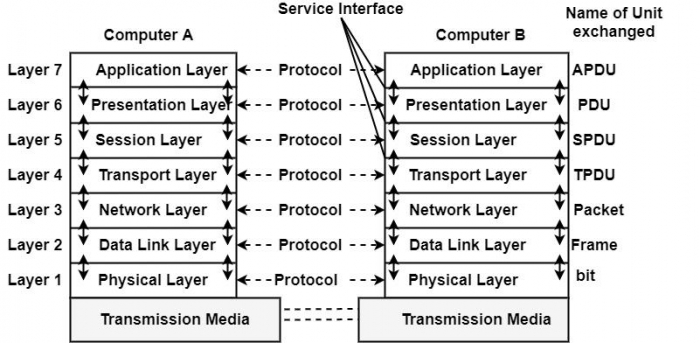
 Data Structure
Data Structure Networking
Networking RDBMS
RDBMS Operating System
Operating System Java
Java MS Excel
MS Excel iOS
iOS HTML
HTML CSS
CSS Android
Android Python
Python C Programming
C Programming C++
C++ C#
C# MongoDB
MongoDB MySQL
MySQL Javascript
Javascript PHP
PHP
- Selected Reading
- UPSC IAS Exams Notes
- Developer's Best Practices
- Questions and Answers
- Effective Resume Writing
- HR Interview Questions
- Computer Glossary
- Who is Who
What is the OSI Reference Model?
OSI represents Open System Interconnection. The OSI reference model is a seven-layered architecture and is created in a hugely structured method. Each layer in the model has specific sets of procedures, functions, and protocols. One layer can communicate with an adjacent layer by using its interface.
OSI model was advanced by the International Organization for Standardization (ISO) in Geneva, Switzerland, and by the Consultative Committee for International Telephone and Telegraph (CCITT).
The figure given below displays the seven-layered Architecture of OSI Models, along with the protocols and interfaces.

Functions of the OSI Layers
There are various functions of OSI Layers which are as follows:
Physical Layer
This is the shortest layer in the model. The physical layer is vital for transmitting bits from one device to the other device. It is not involved with the bits representation, but it manages the physical relation to the structure with communication and signal acceptance.
Data Link Layer
It takes the physical layer’s bits and detects an error. This establishes an error-free communications path between the network nodes over the physical medium. Moreover, it frames the messages for transmission and tests the integrity of received messages. It manages the access to and uses the medium and also ensures the proper sequence of the transmitted data.
Network Layer
The network layer is the makeup software that addresses the protocol data units (PDUs) and transfers them to the ultimate destination. This is done by setting up the suitable paths between the multiple nodes. The primary objective of this layer is to control the service of the subnet. It is the layer, which supports Internet Protocol (IP) to use it. It is mainly responsible for delivering routing services from source to destination across the Internet.
Transport Layer
This layer guarantees the orderly and reliable delivery of data between the end systems after accepting the data from the session layer. The session layer maps the data to the Network layer, and it provides that the packets appear correctly at the receiving side.
Session Layer
This layer is vital for establishing, controlling, and arbitrating the dialogues between the communication software. It is also answerable for the orderly recovery from failures by implementing appropriate check pointing mechanisms.
Presentation Layer
The presentation layer performs the functions related to the syntax and semantics of the information transmitted. These functions include formatting and displaying the received data by terminals and printers. This layer is responsible for rectifying those differences by resorting to mechanisms that change the local syntax to a typical data exchange.
Application Layer
This layer provides the services for user and software tasks. It determines how the user will use the data web. It enables the client to use the network. For example, it provides the network-based services to the end-user.

